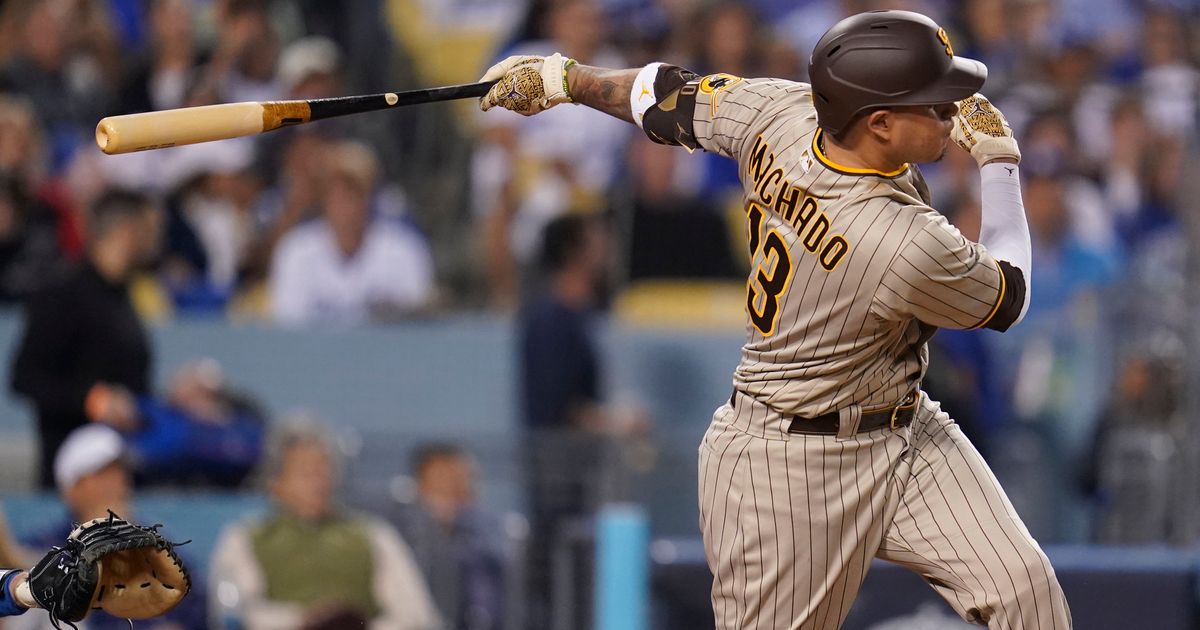
Tick, tock, Manny Machado. Better watch that pitch clock.
Baseball’s new timing device made its big league debut on Friday during a limited schedule of spring training openers and wouldn’t you know it, it was Machado, the San Diego Padres’ All-Star slugger, not a pitcher, who was called for the first violation.
Machado found out the hard way that the pitch clock works both ways. He wasn’t fully in the batter’s box and alert to the Seattle Mariners lefty Robbie Ray as the 15-second clock wound under 8 seconds in the bottom of the first inning. Umpire Ryan Blakney called time and signaled strike one against Machado, who finished second in last season’s NL MVP race.
Machado was hardly fazed. He singled on a 2-1 pitch and then collected another single his second time up.
Machado, who batted between fellow superstars Xander Bogaerts and Juan Soto, laughed about it afterward.
“Going into the record books, at least. That’s a good one. Not bad,” Machado said. “I might just be 0-1 if I can get two hits every game.”
The pitch clock is among several new rules designed to improve pace. Players will have 30 seconds to resume play between batters. Between pitches, pitchers have 15 seconds with nobody on and 20 seconds if there is a baserunner. The pitcher must start his delivery before the clock expires. After a pitch, the clock starts again when the pitcher has the ball back, the catcher and batter are in the circle around home plate, and play is otherwise ready to resume.
Batters must be in the box and alert to the pitcher with at least eight seconds on the clock. Batters can call time once per plate appearance, stopping the countdown.
When a pitcher doesn’t throw a pitch in time, the penalty is an automatic ball. When a batter isn’t ready in time, it’s an automatic strike.
“That time came by quick,” Machado said. “It’s definitely something we’re going to have to get used to. It kind of takes away your routine, being up there and zoning in before the pitch. The umpire gave me a little warning — ‘Hey, you got two seconds’ — but I was already late when I got in there.
“You got 30 seconds and you got to be ready by eight. Forget about walk-up songs for real,” he added with a laugh. “It’s going to be interesting. I always tap the umpire for respect. Those things will start going out of the way.”
Batters can’t leave the box between pitches, “which I don’t mind,” Machado added. “You can just keep a foot in the box and gather yourself again.
“Getting to the box is where it’s going to speed up guys,” Machado said. “Even pitchers, if you’re down 2-0 how are you going to catch a break and lock yourself back in without getting penalized? It’s the same thing going up there when you’re hitting.
“t’s going to be an interesting year. It’s going to be fun. Who knows where this leads? There’s going to be a lot of strategy that goes into this.”
Machado will play for the Dominican Republic in the World Baseball Classic, which won’t have a pitch clock.
“I’m going to take my time,” he said.
Padres starter Nick Martinez added that the clock will make things “a little tricky. Got to find some areas that I can save some time so I can get some time when I need it.”
Martinez said the clock will affect how pitches are called.
“Today the way to alleviate the pressure was having the PitchCom with me,” he said. “For the majority of the time (Luis Campusano) was calling the game but if I had a pitch that kind of stood out for me I just pressed it. I didn’t wait for him to call it, I was like ‘I want this one.’ I did it a few times. There are times when I like to slow the game down, so that’ll be interesting.
“I thought I was not even going to think about it today and I was definitely conscious about it,” said Martinez, who is moving into the rotation after having a hybrid role last year. “I was a little caught by surprise. Definitely going to be an adjustment period.”
___
AP MLB: https://apnews.com/hub/MLB and https://twitter.com/AP_Sports